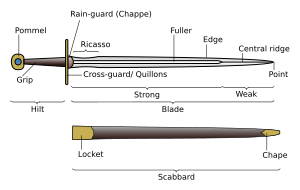Hilt facts for kids
The hilt is the handle of a weapon like a knife, dagger, sword, or bayonet. It's the part you hold! A hilt usually has three main parts: the grip (where your hand goes), the guard (which protects your hand), and the pommel (the end cap). Sometimes, a decorative sword knot or tassel is also attached to the guard or pommel.
Contents
Pommel: The End Cap

The pommel is a larger piece found at the very top of a sword's handle. Its name comes from an old French word meaning "little apple."
Pommels were first designed to stop the sword from slipping out of your hand. Around the 11th century in Europe, they became heavier. This extra weight helped balance the sword, making it easier to move and fight with. Sometimes, a pommel could even be used to hit an opponent, like in a special fighting move called Mordhau.
Pommels come in many different shapes. Some look like moons, disks, or wheels. Others are shaped like animal or bird heads. They are often decorated with engravings, inlays, or even gold and jewels.
Grip: Where You Hold On
The grip is the main part of the hilt that you hold. It is usually made of wood or metal. Often, it's covered with materials like shagreen, which is a tough leather from shark skin. Shark skin was very strong in cool places. But in hot places, it didn't last as long. So, rubber became popular in the late 1800s.
Some sword types, like the katana, use ray skin on the grip. No matter the material, the grip is usually glued on and then wrapped tightly with wire in a spiral shape.
Guard: Hand Protector
The guard is located just above the grip. Many people think the guard protects the whole hand from an enemy's sword. But early guards mainly stopped the hand from sliding up the blade. A full hand guard became important later, when people stopped using shields and heavy armored gloves.
Even so, the guard was very important. It protected the user from a blade that might slide down their own sword to cut their hand.
From the 11th century, European sword guards often looked like a straight bar. This bar was placed across the blade, and it was called a "quillon."
Starting in the 16th century in Europe, guards became much more complex. They had extra loops and curved bars to protect the hand even more. A single curved piece that went along the fingers was called a knuckle-bow.
Eventually, these bars could be replaced with metal plates. These plates often had fancy designs cut into them. Swords with these very protective designs were called "basket hilts." There are many different kinds of basket-hilted swords.
At the same time, swords like rapiers and smallswords became popular for thrusting attacks. This showed a weakness to enemy thrusts. By the 17th century, new guards were made. These had a solid shield that went around the blade. Older versions still had quillons, but later ones removed them. These were called cup-hilts. Modern foils and épées used in fencing still have guards based on this design.
Ricasso: The Unsharpened Part
The ricasso is a dull, unsharpened section of the blade. It is found just below the guard. On some swords, the guard extends to protect this part.
On very large two-handed swords, the ricasso gave a third place for a hand to grip. This allowed the user to hold the sword further apart for better control and power.
Sword Knot: Style and Safety
A sword knot or sword strap is also sometimes called a tassel. It's a lanyard, usually made of leather. But it can also be made of woven gold or silver threads. This loop goes around your hand. It helps stop you from losing your sword if you drop it.
Even though they are useful, sword knots often have beautiful designs. For example, the British Army used a white leather strap with a large acorn-shaped knot for infantry officers in the late 1800s. These acorn tassels were "boxed," meaning their fringes were secured so they wouldn't get tangled. Many sword knots were also made of silk with fine, decorative metal wire woven into them.
In India, sword tassels were attached through a small hole at the end of the pommel.
Chinese swords, like the jian and dao, often have lanyards or tassels. Like Western sword knots, these are both decorative and practical. Moving the tassel is even part of some jian sword performances.
Hilt Ring: Just for Looks
The hilt ring is an extra part that can be added to a sword. It is used only for decoration.
See also
 In Spanish: Empuñadura para niños
In Spanish: Empuñadura para niños





